Fat oxidation is a process in which the body breaks down lipids, releasing energy to fuel your performance. But why is using fat as a fuel important for endurance performance? How does your body decide to use fats rather than sugars? And how can you develop your fat oxidation capacity to boost your fuel efficiency and your power output? If you’re a coach or an athlete, this article will help you better understand how your body functions and how you can make it work even better.
In this article, we will take a dive into what fat oxidation is and how to make your body burn more fats than sugars during exercise. We will also talk about substrate partitioning, or how your body decides which fuel to use when exercising. Finally, we will look at different types of training interventions and what their actual effects are on fat utilisation.
Let’s dive in!
Fat Oxidation During Exercise & Endurance Performance
First, let’s understand how your endurance performance will be impacted by fat oxidation.
During exercise, your body mainly uses sugars, fats together with oxygen in order to recycle the ATP that is being broken down. ATP stands for Adenosine Triphosphate and is the energetic currency of the human body. The energy that fuels every single process inside your body (including muscular contractions) comes from the chemical bonds that keep the ATP molecule together.
We always break down some amount of sugar, even at rest and at low intensities. So why do we have to think about fat oxidation? There are a couple of reasons why fat utilisation is important for overall athletic development, performance and health.
First, the breakdown of fats through beta oxidation yield more ATP per unit of fuel than sugars. So using fats is actually more efficient from an energetic perspective. The second reason is because of the size of our fuel reserves.
Let me explain:
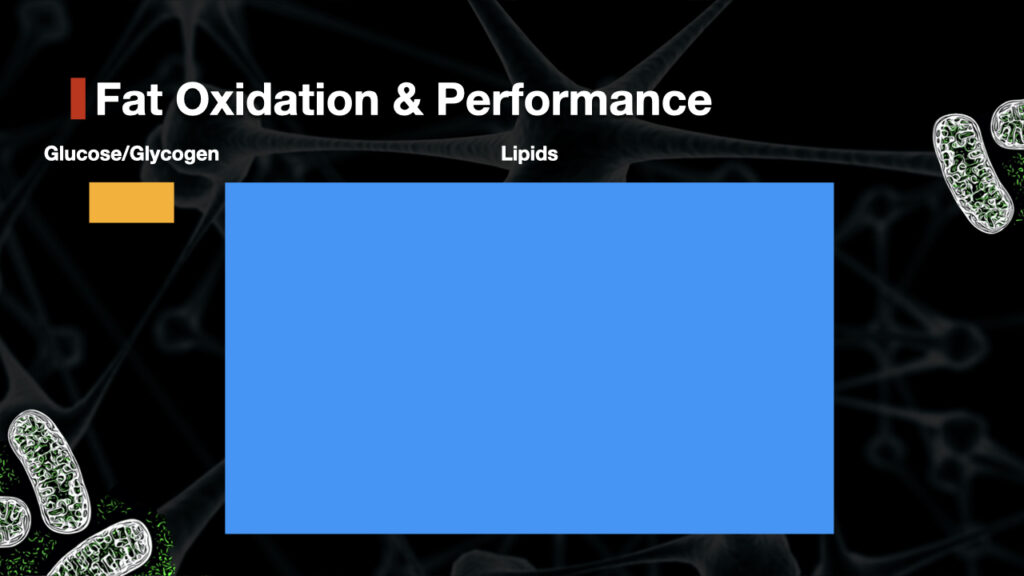
As you can see in the picture above, we have a LOT more fat stores than glucose/glycogen stores inside the body. And this has nothing to do with how much body fat your carry. Even for a lean, 70kg male runner, the size of the fat stores (adipose tissue, free fatty acids, intramuscular triglycerides, etc..) far surpass the stored sugars.
Spare your Glycogen
Glucose/glycogen are extremely importante for high intensity efforts such as when you need to win a race in the final sprint! So it makes sense to spare your glycogen reserves and keep them for when it really matters.
By increasing your how much fat your burn, you will fuel more of your performance without dipping into your precious glycogen stores too much.
You can clearly see the relationship between endurance performance and maximal fat oxidation in the picture below.
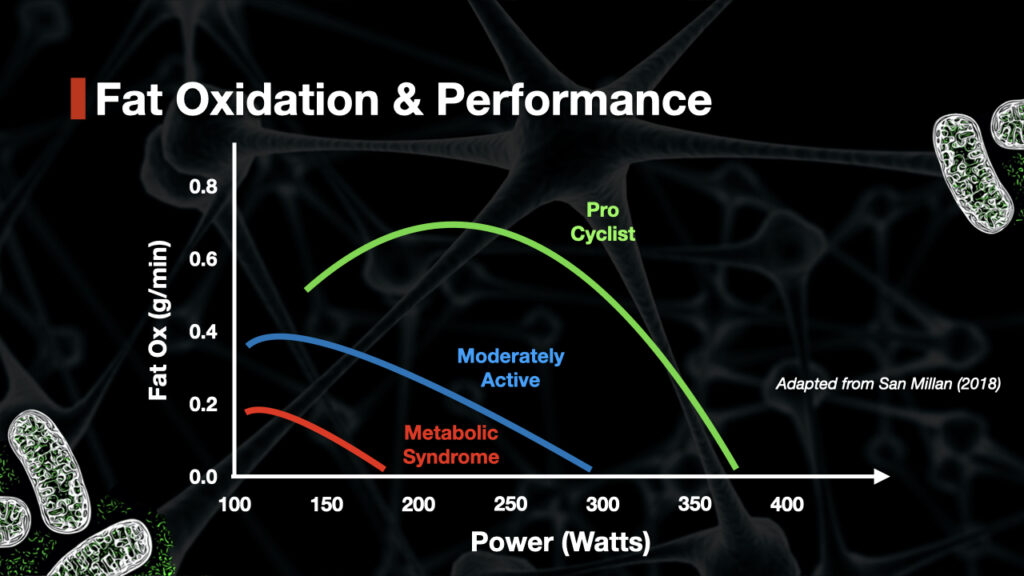
Before we try and understand how to increase our fat burning capacity, let’s first figure out how the body chooses which fuel to use during exercise.
Fuel Choice for Exercise: Fats VS Sugars
We’ve already determined that by burning more fats, we can spare our small glycogen reserves for when we need them the most. But how can we push the body to use more fats for fuel? What dictates substrate partitioning? This is what we’re going to investigate in this part of the article.
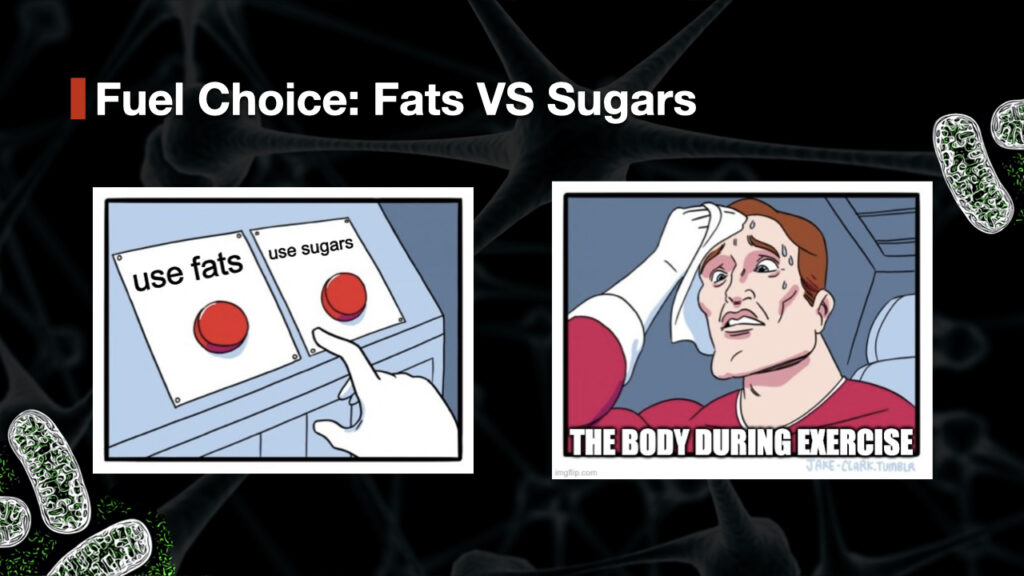
First let’s set the scene.
At rest, we have a high ATP/ADP ratio inside the cytosol of our muscle cells. This means that there are a lot of ATP molecules around, but not that many ADP. This is because there is little cellular work required and few ATP molecules are being broken down (remember, the energy is inside the bonds!).
The ADP (or AMP) is then recycled back into ATP inside the mitochondria. The mitochondria is the powerhouse of the cell. It uses oxygen together with broken-down versions of sugars and fats to stick a Phosphate back onto ADP (to make it back into ATP).
Mitochondrial Capacity & Glycolytic Activity
Here it’s important to understand that ADP activates Glycolysis. In case you didn’t know, glycolysis is the breakdown of sugars (glucose or glycogen) into pyruvate/lactate. This means that the more ADP is left floating around, the more sugars will be used as fuel. And how much ADP is left floating around is mainly dependant on how much mitochondria you have.
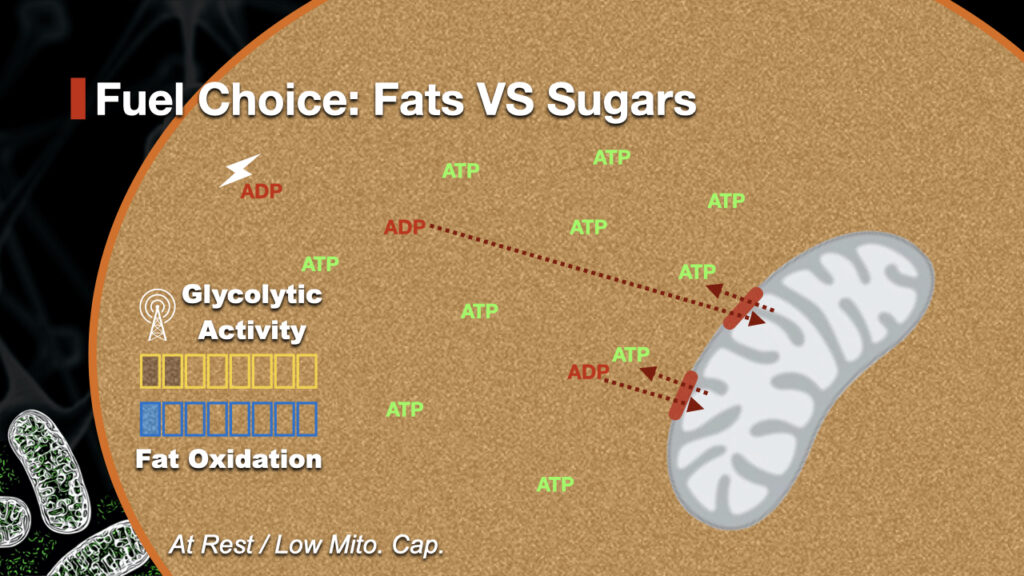
Now let’s look at this in the context of exercise.
As muscular contractions occur, more ATP gets broken down. This shifts the ATP/ADP ration down towards a higher concentration of ADP. Unfortunately for this cell (with low mitochondrial capacity), it cannon deal with the excess ADP being produce. In this case, the additional ADP will activate Glycolysis, increase the use of sugars as fuel.
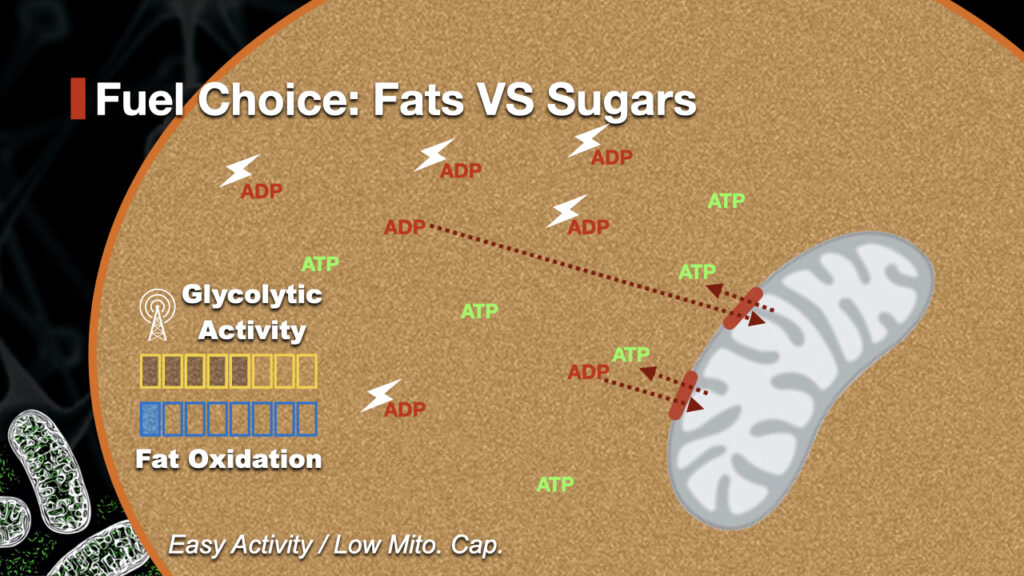
High Mitochondrial Capacity Increases Fat Oxidation
In the case of a more developed mitochondrial network, more ADP will be “buffered”. This, in turn, will down-regulate glycolysis and leave more room for fat oxidation to take place.
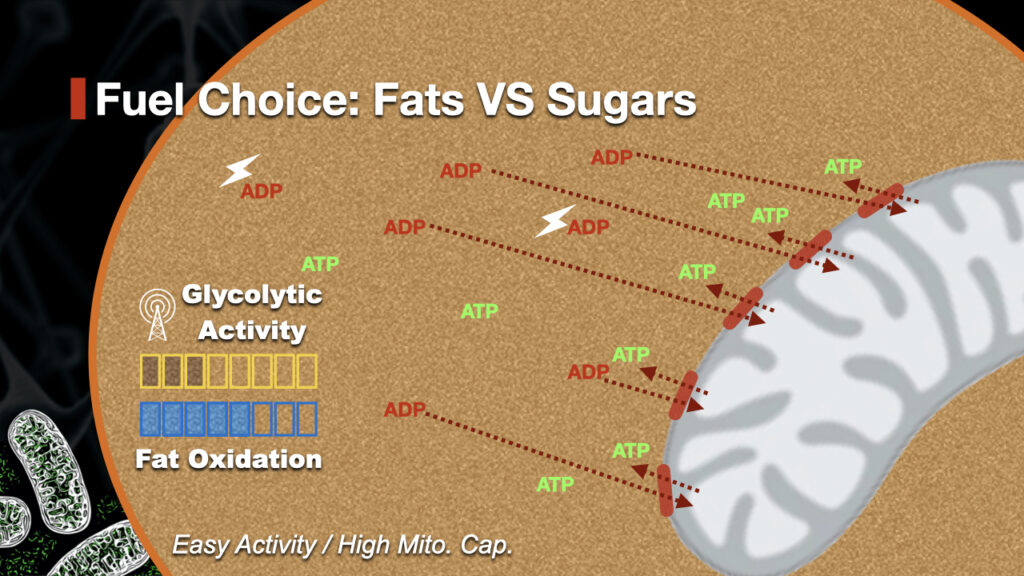
We now understand that mitochondrial capacity has a big role to play in using fats as a fuel. Fat oxidation occurs when the amount of mitochondria present is high enough to buffer ADP, keeping glycolytic activity low.
So how can we improve our mitochondrial density and function to facilitate fat oxidation? Let’s look at this in the next section.
Increase Fat Oxidation with Endurance Training
The main way we can develop mitochondrial density (and improve maximal fat oxidation) is through endurance training. But not all training intensities are the same! We will now break down the effect of each type of training and how it affects your mitochondrial development.
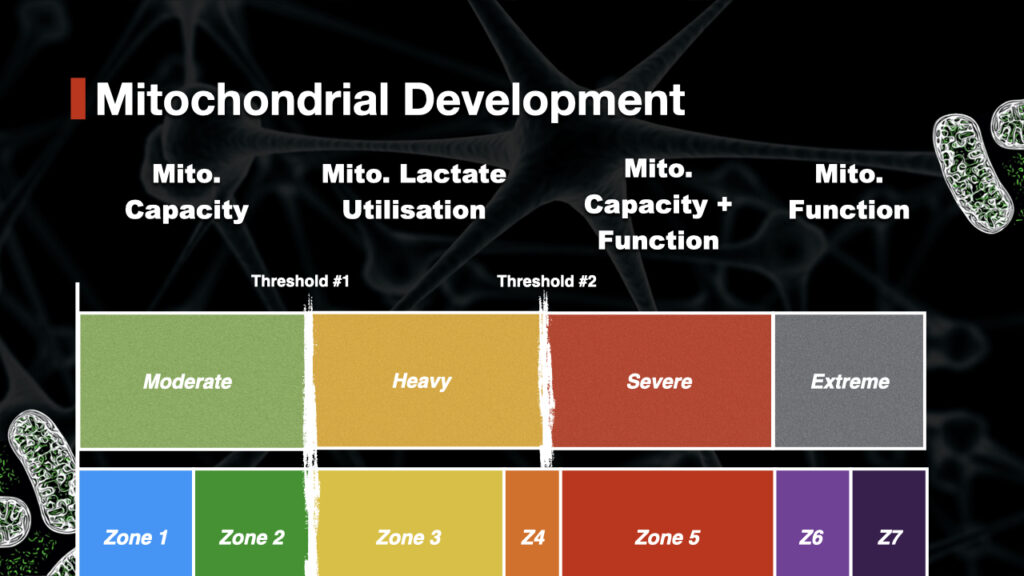
At the bottom of the intensity spectrum we find the moderate intensity domain. This domain sits below the first threshold and usually corresponds to Zone 1 and Zone 2. This type of training is really easy and can be done for many hours. Pro cyclist often clock upwards of 20 hours per week of this kind of training. This is where most of the mitochondrial density/volume will be developed. This is also where you’ll get the maximal fat oxidation rates.
The advantage of this low intensity training is that is generates very little fatigue on the body. So you can do A LOT of it without burning out. Make sure you know what your physiological zones are to optimise your training.
Once we pass the first threshold we get to the heavy intensity domain. At those intensities, lactate levels will rise above baseline yet remain stable. This internal environment will help develop your body’s ability to transport and utilise lactate as fuel. If you’ve head of training terms such as “tempo”, “sweetspot” or “threshold”, this is usually the type of training that’s being referred to.
This type of training is obviously necessary for endurance performance. But performing too much of it without adequate recovery and without a strong low intensity foundation can have a negative impact on your mitochondrial development.
Training above Threshold #2
The second threshold is commonly referred to as the Anaerobic Threshold, Critical Power/Speed or Maximum Lactate Steady State. Once we move beyond this grey zone, we transition from the heavy to the severe intensity domain.
The severe intensity domain will usually see the appearance of VO2max, high lactate levels and task failure within 3-30 minutes. At those intensities, very little (if any) fat is used as a substrate, because all the “space” it taken up by lactate (the byproduct of glycolysis). However, we do see the development of both mitochondrial capacity AND function with those types of training sessions.
The downside if this type of training if that it is very taxing both metabolically and mentally. So accumulating large amounts of this type of work is not recommended. It should however be used as part of a structured training program with a sound intensity distribution.
Beyond the severe domain we enter what’s called the extreme intensity domain.
This training is also known as Sprint Interval Training (SIT) or “Wingate Sprints”. These are usually all-out efforts performed for anywhere from 6 to 60″ at a supra-maximal intensity. These intense sessions seem to trigger mitophagy or the planned destruction of “old” mitochondria to be replaced with newer, better functioning ones.
Understanding Mitochondrial Development thought Endurance Training
For a full review of our current understanding regarding training and mitochondrial development, check out David Bishop’s great presentations below:
To conclude this section we can say that a well-balanced endurance training program will yield the best mitochondrial development over time. This in turn will improve our fat oxidation ability and our performance.
Now what is the link between fat oxidation and fat loss? Does improved fat oxidation increase your ability to burn/lose weight? Let’s look at it in more detail.
Training Program to Improve Your Fat Oxidation
Fat Oxidation vs Fat Loss
It’s important to understand that those two phenomena sound very similar but are not the same thing.
Fat Oxidation describes the utilisation of fatty acid molecules by the mitochondria to recycle ATP. Fat Loss describes a decrease in fat mass at the whole body level. We saw that fat utilisation is largely dictated by mitochondrial capacity. Instead, Fat loss is the result of maintaining a sufficient caloric deficit over time. Provided the right hormonal environment (adequate sleep and low stress levels), the body will usually “use up” its adipose stores when placed in a caloric deficit. So while improving fat oxidation is beneficial for both your health and performance, there won’t be any direct impact on your fat loss.
As I like to say, if you wish to lose fat or lose weight, you should eat like an adult and sleep like a baby!
You’ll find more information about this topic in my recent presentation on Youtube:
Additional Reading on Fat Oxidation
San-Millan et al. (2008), Assessment of Metabolic Flexibility by Means of Measuring Blood Lactate, Fat, and Carbohydrate Oxidation Responses to Exercise in Professional Endurance Athletes and Less-Fit Individuals, Sports Medicine
Kindal A Shores (2000), Metabolic Adaptations to Endurance Training: Increased Fat Oxidation, Honours Thesis
Frequently Asked Questions about Fat Oxidation
Fat oxidation is the process by which the body breaks down fats (triglycerides) into smaller molecules, such as free fatty acids and glycerol, which can then be used as a source of energy. This process occurs primarily in the mitochondria of cells and is an important part of the body’s energy metabolism.
Fat oxidation increases mainly through training and via an increase in mitochondrial capacity. This has a sparing effect on glycogen stores allowing the athlete to perform better later in the race.
There are several ways to measure fat oxidation, including:
Indirect calorimetry: This involves measuring the amount of oxygen consumed and carbon dioxide produced during exercise or activity, which can indicate the body’s use of fat as fuel.
Stable isotope techniques: This involves consuming a small amount of a labeled form of fat, such as octanoate, and then measuring the labeled carbon in exhaled breath or urine to determine the rate of fat oxidation.
Blood tests: Measuring the levels of certain fatty acids and ketone bodies in the blood can also provide an indication of fat oxidation.
Body composition analysis: Dual-energy X-ray absorptiometry (DXA) and bioelectrical impedance analysis (BIA) are two common methods to measure body composition, including body fat percentage, can also give an indication of the rate of fat oxidation.
Please note that these methods have different level of accuracy and some of them may require professional assistance.
By performing more low intensity training and developing your mitochondrial density.
Not directly. However increasing your activity levels will be beneficial for both your performance and your health. Maintaining a reasonable caloric deficit over time is the best way to lose weight and body fat.
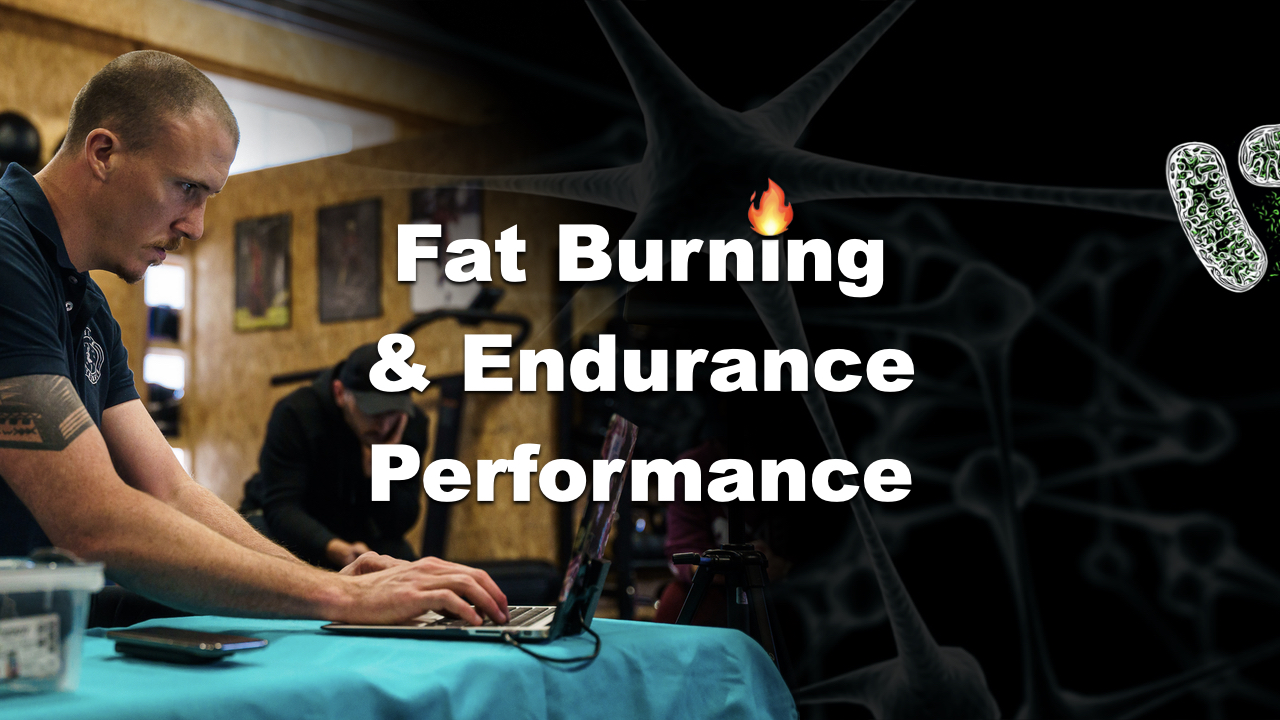

thank you for making this article
thanks a lot of information good